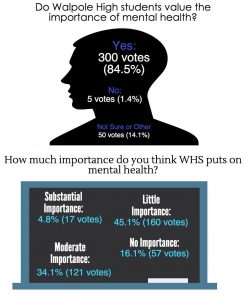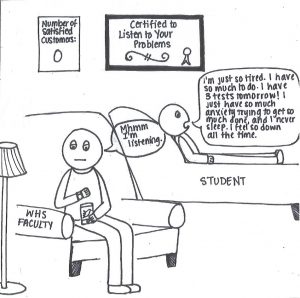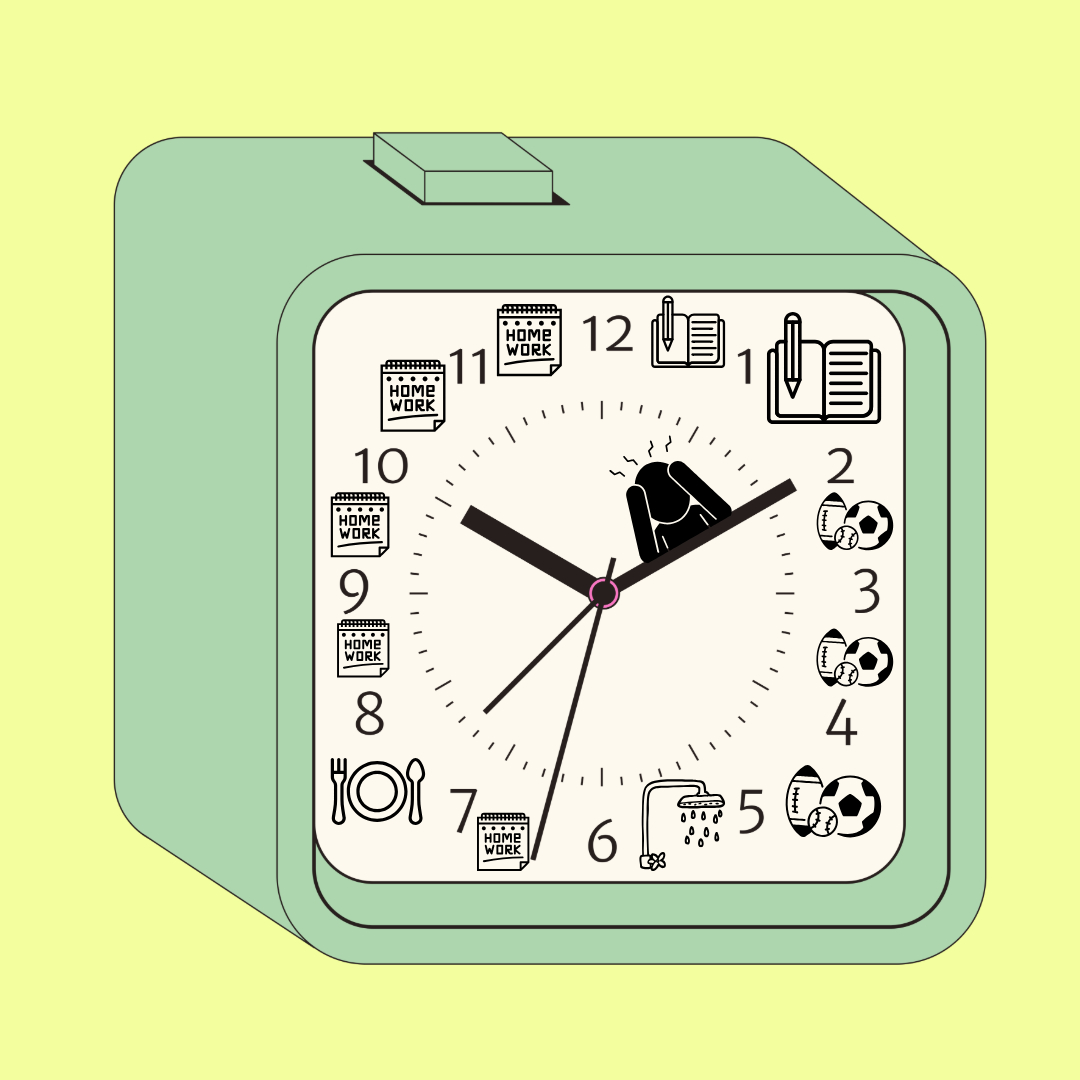
By Nirupa Abraham, Meaghan Luong, and Cathrine Paul
How many of us say “I’m fine” when in reality, we are on the brink of a mental breakdown, or shirk away from talking about how we really feel? The majority of societal pressures are causes of mental health illnesses, such as anxiety and depression that can even result in suicide. In schools especially, the issue of mental health has become more apparent as students undergo external and internal pressures. Students are expected to balance their social lives, academics, extracurriculars, and much more, all while maintaining a positive attitude; however, maintaining a positive attitude can be difficult in a high pressure environment.
Walpole High School claims to care about its students’ health, yet it turns a blind eye when it comes to students’ mental health. In a survey conducted in Walpole High School regarding mental health, 355 students—about one-third of the student body—responded. 226 students said they would rather speak to a friend rather than a teacher or guidance counselor. This results seems to indicate that students feel uncomfortable discussing the topic with school faculty. The distance between staff and students suggests the school’s negligence to mental health.
Three hundred surveyed students said they valued the importance of mental health, but only 74 students felt that Walpole High School puts moderate or substantial importance on mental health. With the pressures and rigor present within the typical Walpole High School student’s schedule, their discontent with the lack of emphasis placed on mental health is understandable.
The faculty at Walpole High School does feel as though they do place an importance on mental health.

“When a student comes to see one of us, especially if they are in crisis, we take the situation very seriously and respond immediately,” said guidance counselor Elizabeth Doran.
The school does provide safe places—the SOS Box, Guidance, and school psychologist—for students to voice their concerns. In addition, on Dec. 15, 2015, the Fire Within program received a national recognition for their participation in a social entrepreneurship competition in which they created a planner designed to promote efficient time management in order to decrease student stress. However, students still do not feel as though these actions are enough.
“We place a shallow emphasis on stress reduction and preventing suicide—guidance seminars and the like, including a classroom visit junior year—but don’t give easy access to mental health services,” said one student in the survey. “Mental health stigma pervades WHS as it does practically everywhere else.”
The reason for the discrepancy between how students feel and what faculty believes they are doing to deal with the issue of mental health is due in part to how most students view mental health.
Mental health, like physical health, can surmount to greater problems if left untreated, but generally speaking, society does not weigh the two with equal importance. The school can conduct all the seminars it wants, but no effective measures can be taken if the school culture around mental health does not change.
Students need to see how their state of mind and emotional well being is just as important as academics, sports, social lives, and the other aspects of daily life. The process to change the cultural stigma is a tedious one that goes beyond the classroom, but as a community we can take preemptive steps towards providing students with the help they need, while also spreading greater awareness and understanding in regards to the topic.
The first step is for teachers to have a better understanding of what students are going through. Most of the comments in the survey center on copious amounts of school work—in addition to other commitments like jobs and sports—resulting in a lot of staying up past midnight and missing days of school. While teachers may not be able to do away with necessary homework and assignments, educators need to have a better understanding that many students are pushing themselves past the breaking point to accomplish all that they have to.
Today’s society, especially in regards to education, has become overly competitive. When a student who takes several AP courses, plays a sport, does drama, and has a part time job cannot get more than 3-5 hours sleep per night, there is a problem.
This lack of rest causes an accumulation of stress and anxiety which could lead to more serious things like depression and so forth. In order to ameliorate the issue, the school first needs to understand that students are under unrealistic amounts of pressure in their day to day lives. Teachers and faculty should then work towards balancing the amount of work students receive from each class so they are not overwhelmed with the amount of school work.
If school culture surrounding mental health is going to change, each and every single member of the school, student and faculty alike, must work towards not only bringing awareness but also finding ways to help those struggling with mental health.













